What are the Names of Wood Carving Tools: A Complete Guide

Wood carving is a timeless, beautiful, heart-touching art that transforms raw wooden blocks into intricate and breathtaking creations.
To start this creative journey, it is essential to be aware of the fundamental wood carving tools that form the bedrock of this age-old craft.
In this article, I will provide a detailed guide about the essential instruments and tools that every beginner or expert wood carver should keep in their toolkit.
Because tools play an important role in fulfilling this hobby.
So, keep reading.
What are the Names of Wood Carving Tools
Manual Wood Carving Tools Names
Here below is the list of manual wood carving tools names that take part in the process of carving.
- Carving Knives
- Gouges
- Chisels
- Mallet
- Sharpening Tools
- Rasps and Files
1- Carving Knives
These tools play a very important role in wood carving work. In the market, they are available in various shapes and sizes, each with specific characteristics to do their tasks. Carving tools are very affordable compared to other carving tools.
- Detail Carving Knife: It is designed for intricate and delicate work, which adds fine
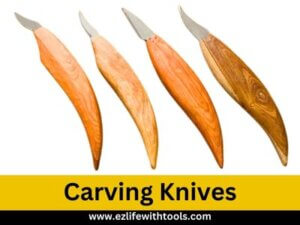
Names of Wood Carving Tools details to the projects.
- Hook Knife: These knives are ideal for carving concave shapes like bowls and spoons.
- Bird Carving Knife: These knives have a fine, pointed tip and are used to create bird sculptures.
- Sloyd Knife: It is a versatile general-purpose knife with a straight blade, often used for whittling and carving. It is available in different blade sizes like short-blade sloyd, long-blade sloyd, compound-curve sloyd.
- Chip Carving Knife: These knives have a unique blade shape specially designed to create precise chips and geometric patterns.
- Stab Knife: These knives have a pointed tip and are used to create intricate designs with dots and short lines.
- Parallel Ground Knife: These knives have a parallel-ground blade, which means that both sides of the blade are angled equally. It is suitable for achieving straight and precise cuts in chip carving.
2- Gouges
Gouges are chisels with a U-shaped curved cutting edge for crafting rounded or concave shapes in wood carving. Available in various sizes and sweeps.
Whether crafting a decorative flourish or sculpting a detailed figure, gouges are instrumental in achieving your desired results.
- Spoon Gouge: It is designed for carving spoons and bowls. These gouges have a deep, rounded shape.
- Fishtail Gouge: These gouges are versatile and can be used for convex and concave carving.
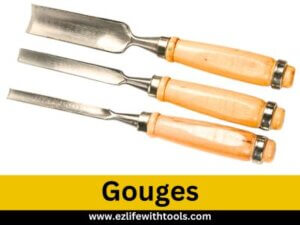
Names of Wood Carving Tools - Back-Bent Gouge: These gouges are excellent for reaching tight spaces and achieving intricate details.
- Front-Bent Gouges: In contrast to back-bent gouges, front-bent gouges have a cutting edge that curves toward the front. This design allows for enhanced control and visibility when carving intricate patterns.
- Long Bent Gouge: With a long, gently curved cutting edge, these gouges are suitable for carving large, sweeping curves.
- Bowl Gouges: As the name suggests, bowl gouges are specially designed for carving bowls and concave shapes. They have a deep U-shaped profile, allowing for efficient material removal when hollowing out the interior of a wooden bowl.
- Sweep Gouges: These gouges have different curvature profiles, referred to as “sweeps.” The sweep number indicates the depth and curvature of the gouge. For instance, a #3 sweep gouge has a deeper curve than a #7 sweep gouge. We can use different sweep gouges to achieve specific shapes in their carvings.
- U-Gouge: Featuring a U-shaped cutting edge, U-gouges are versatile tools for carving a wide range of curved and concave shapes.
- Veiner Gouge: These gouges have a V-shaped cutting edge and are used for creating fine lines, veins in leaves, and other delicate details.
- Complicated Gouges: Some specialized gouges have complex shapes to accommodate unique carving requirements.
3- Chisels
Chisels are the fundamental tools in wood carving to make straight, flat cuts to achieve clean edges in projects. Chisels come in various widths to accommodate different carving tasks. It is especially useful for efficiently removing larger sections of wood.
- Parting Chisels: A long, thin chisel with a V-shaped cutting edge designed for precise
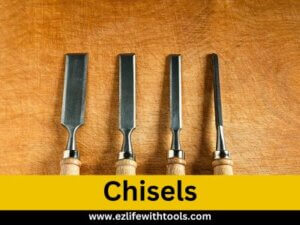
Names of Wood Carving Tools and delicate carving tasks.
- Firmer Chisels: It is known as all-purpose chisels used for various carving tasks.
- Mortise Chisels: Square-edged chisels used for cutting rectangular holes for joints.
- Skew Chisels: It is designed to create angled and beveled cuts.
- Japanese Chisels: It is very sharp and is used for quality work, available in different styles like dovetail, bench, and paring.
- Carving Chisels: It is specially designed for wood carving to apply multiple techniques available in different shapes and sizes.
4- Mallet
It is an essential tool, a wooden or rubber head. We use it alongside chisel and gouges. It provides the necessary force to drive these tools through wood without causing damage to
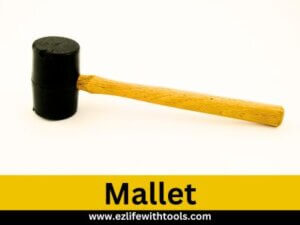
the carver.
Choosing the right mallet ensures control and precision in your carving work.
- Round Mallet: It is a traditional mallet with a round head for balanced striking.
- Square Mallet: It has a square head, which provides more control and precision.
- Weighted Mallet: Some mallets have added weight for extra striking power.
- Carver’s Mallet: Designed specifically for woodcarvers, these mallets often have ergonomic handles for comfortable and controlled use.
5- Sharpening Tools
We’ll need sharpening equipment like sharpening stones, honing guides, and strops to maintain our tools. Because dull tools are more likely to slip, that can cause accidents or bad results.
A well-sharpened tool not only ensures cleaner cuts but also prolongs the life of our carving
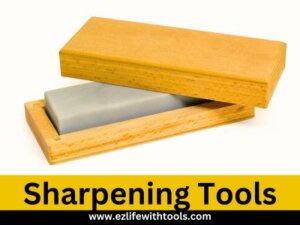
instruments.
- Sharpening Stones: Available in different grits for coarse to fine sharpening.
- Honing Guides: Tools that help maintain consistent angles while sharpening.
- Strops: Used for polishing and honing the final edge of your carving tools.
- Diamond Plates: Efficient and long-lasting sharpening surfaces.
- Grinding Wheels: Motorized wheels for heavy-duty tool sharpening.
- Oilstones: Sharpening stones use oil as a lubricant and to carry away metal particles.
6- Rasps and Files
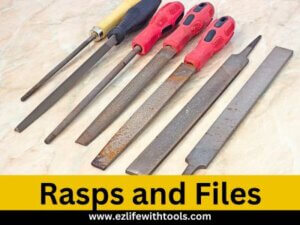
These tools used for shaping and refining wood surfaces in wood carving are available in various sizes and shapes, and each is designed for specific tasks, from rounding edges to creating texture and smoothing surfaces.
Rasps are typically used for rough shaping and removing excess wood quickly.
While files are used for finer, smoother, and more detailed work.
Using this, we can easily achieve the desired contours and finishes on the projects.
What are the Names of Wood Carving Tools
Power Wood Carving Tools Names
Here below is the list of power wood carving tools names that take part in the process of carving.
- Rotary Tool (Dremel)
- Power Carving Unit
- Angle Grinder with Carving Disc
- Router
- Electric Engraver
- Jigsaw
- Mini Lathe
- Belt Sander
- Oscillating Multi-Tool
- Foredom Flexible Shaft Tool
- CNC Wood Carving Machine
- Wood Burning Kit
1- Rotary Tool (Dremel)
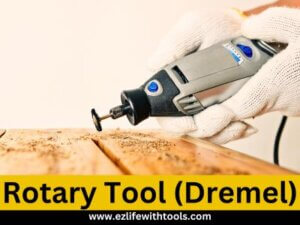
It is a versatile handheld high-speed power tool. It has a variety of attachments, like carving bits, sanding drums, and engraving tips.
All these attachments, compact size, and ease of control make it a popular choice for fine detailing and intricate work in wood carving projects.
It is used for multiple tasks, like carving, engraving, and sanding. It is the most used tool in wood carving and is available at an affordable price.
2- Power Carving Unit
A power carving unit is a motorized system with
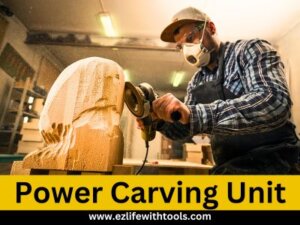
different handpieces and attachments for various carving tasks.
It is also known as a power carver or electric carving tool. These units often feature variable speed controls, allowing woodcarvers to adjust the tool’s power to suit their needs.
Artists, craftsmen, and woodworkers love to work with this tool because it creates detailed designs more efficiently than traditional hand-carving tools.
It is a valuable addition to any wood carving workshop.
3- Angle Grinder with Carving Disc
The carving disc typically features chainsaw-like teeth or abrasive surfaces, allowing for aggressive wood removal while maintaining control with an angle grinder.
Angle grinders with carving discs are frequently used in large-scale carving projects, such as creating sculptures or working on outdoor wooden structures.
4- Router
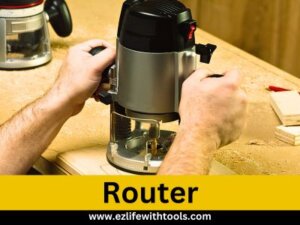
A router is a power tool that has excellent results in creating patterns, profiles, and edges in wood. Its specialty is hollowing, shaping, and adding decorative details to the projects.
Routers have several types, including handheld and table-mounted models, each with its own set of features and capabilities like edge profiling, dadoes, groves, sign making, trimming, flush cutting, joinery, and inlays.
5- Electric Engraver
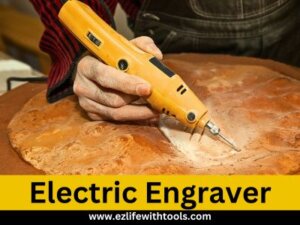
An electric engraver is a handheld power tool designed for etching or engraving designs, patterns, text, or markings onto various surfaces, such as metal, wood, glass, plastic, and stone.
It has a vibrating mechanism to create different marks and patterns. This tool is normally used for personalized items to add signatures, text, labels, and artistic work.
6- Jigsaw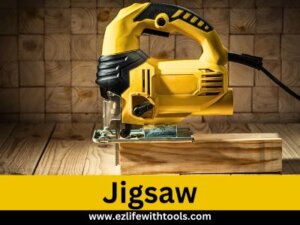
It is a very popular power tool, also known as a saber saw, used for creating curved and intricate cuts in wood.
It is a perfect choice for carpenters, woodworkers, and DIY enthusiasts because it can make curved, bevel, and straight cuts with a reciprocating blade that moves up and down.
7- Mini Lathe
It is a small-scale but powerful benchtop machine tool for multiphase like wood, metal, and plastic.
We can create cylindrical, tapered, flat shapes, interior and exterior threads, table legs, spindles, and decorative columns.
8- Belt Sander
Belt sanders are essential tools that come in handy for doing many things at once, like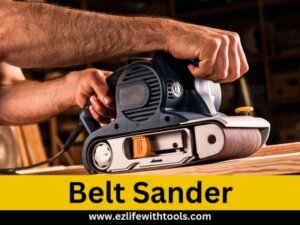 shaping and smoothing wood quickly and efficiently.
shaping and smoothing wood quickly and efficiently.
It has a loop of sandpaper that rotates over two drums for leveling surfaces, removing rough spots, and refining the shape of their carvings.
Belt sanders come in various sizes. It has a belt tracking system to ensure that the sanding belt is centered on the rollers and in line with the sanding surface because proper tracking is crucial for even and efficient sanding.
It is connected to a mini vacuum system that collects the dust to clean the working site and project.
9- Oscillating Multi-Tool
These are versatile instruments with multiple attachments for cutting, sanding, and grinding.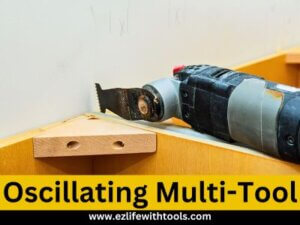 We can use it to make precise cuts of material removal in tight spaces to achieve smooth finishing.
We can use it to make precise cuts of material removal in tight spaces to achieve smooth finishing.
It has variable speed controller functions, and we can adjust its speed according to the project’s nature and design. Another important feature is a depth controller.
We can set a depth value; it will be stopped automatically when it reaches the assigned depth.
These are the perfect choice for those projects that require very difficult craftsmanship with detailed carving.
10- Foredom Flexible Shaft Tool
The Foredom tool is an invaluable multifunctional tool that can speed up carving due to the speedy motor.
Foredom Electric Company manufactures this tool and is a reputable brand for producing high-quality rotary tools and accessories.
It is not used in woodworking only but also used for jewelry making, metalworking, dental and orthopedic, art and craft work. It can easily reach into small spaces.
11- CNC (Computer Numerical Control) Wood Carving Machine
It is a computer-controlled machine that automatically automates the carving process based on digital designs and templates.
We can accurately create complex patterns, beautiful designs, and 3D carvings. It is recommended for highly precise and intricate wood carvings.
CNC machine is a favorite and valuable asset for professional woodcarvers and artists. It is used in industries on a commercial basis due to its high price.
12- Wood Burning Kit
A wood burning kit, also known as a pyrography tool. We use it to create decorative purposes and artistic expression. It requires specialized tips to burn the wood, resulting in beautiful and detailed artwork creation.
Wood burning adds depth and texture to carvings. It is a very popular method for high-class decoration.
Conclusion
In this article, I have described all the wood carving tools names with their types and uses. Both manual and power woodcarving tools are the asset of any woodcarver or craftsman.
Manual tools help, but take some time.
On the other hand, power carving tools provide efficiency with speed to achieve our results in minimum time.
The selection between manual and power carving tools depends on the specific type of project, the desired level of accuracy, and our personal choice interest.
Now it’s your turn to choose your desired tools from the given wood carving tool names according to your project needs.
Thank you for your precious time.
Best Wishes
Frequently Asked Questions
Which material is used for making wood carving?
Different type of wood carving tools are in the market, but basic wood caving tools like, knife, gouges, scale and teak wood used for making carving.
What are the wood carving tools called?
Wood carving involves various tools designed for specific purposes. Some wood carving tools include Chisels, Gouges, Mallet, Rasps, Files, Carving Knives and Sharpening tools etc.
How do I carve wood?
If you want to create a masterpiece of wood carving then always follow the grain direction to carve along the fiber.
What is hand carving?
Using manual wood carving tools without the electric energy is called hand carving. Basically there are two categories in wood carving, manual wood carving and power wood carving. We don’t need any type of energy to operate the manual tools, while power tools required electric energy to perform their work.
Can you carve all wood?
The basic specifications of carving wood are tight grain and hard piths, which is mostly found in wood from fruits and nuts. All types of wood with these specifications are eligible for carving.

